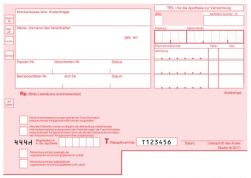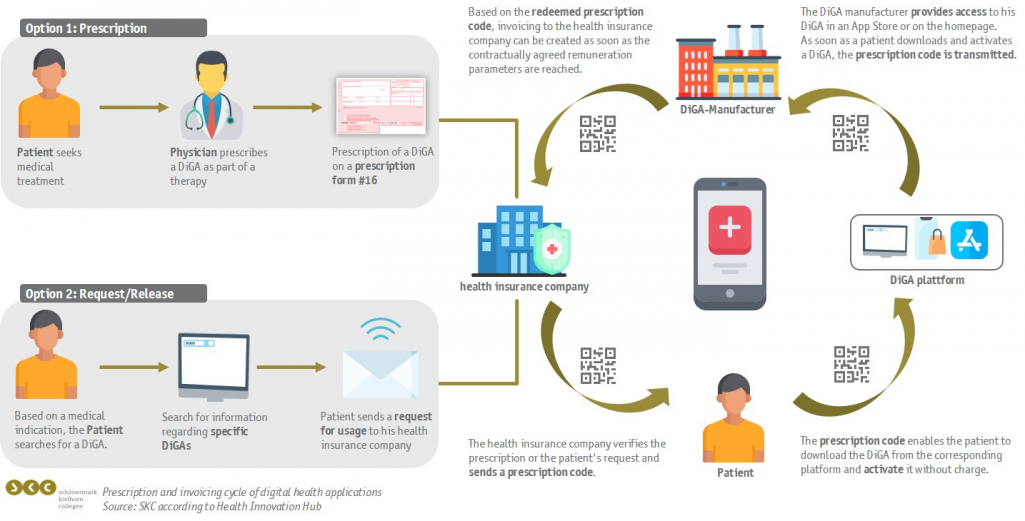Prescription of digital health applications
a further step towards clinical practice
In the last few weeks, the umbrella associations of the DiGA manufacturers together with the health insurance companies and the GKV-SV developed a prescription and accounting solution for DiGAs. The involved parties presented their concepts during the DiGA "Sprechstunde", a conference format initiated by the Health Innovation Hub - HiH. As described by the participants, several hurdles had to be mastered, as the process of prescribing a DiGA represents a new milestone for which no corresponding prescription and accounting mechanisms existed. To ensure a timely implementation, they agreed on provisional paper-based prescription mechanisms, using already established procedures.

As with all other SHI services, the established principle of benefits in kind should also apply to DiGAs: Patients should not have to purchase a DiGA in advance. Patients are supposed to receive a prescription, which they can redeem at a favorable place. As the most suitable intermediate solution, the familiar prescription form "Muster 16" (for pharmaceuticals, bandages, and medical aids) was chosen, for which no completely new payment scheme had to be created. The use of pseudo-pharmaceutical registration numbers (pseudo-PZNs) enable the immediate implementation of a payment scheme without extensive adaptation of the Medical practice management software. Although a paper-based solution has been chosen, all participants emphasized that the entire prescription and billing process will be completely digital in the future.
According to the defined procedure, the patient receives a prescription of a DiGA from a physician with an associated pseudo-PZN, which the patient forwards to her/his health insurance company. The prescription always refers to a specific manufacturer- dependent DiGA. The possibility of prescribing "DiGA classes", so that the patient can choose from a range of DiGAs from different manufacturers, has not yet been provided by law. However, patients don't necessarily require a prescription as they could also contact their health insurance company directly. Nevertheless, the patient must enclose appropriate proof of a medical indication with their request. In both cases, the health insurance company creates a prescription code, which is used for the entire activation and invoicing process of a DiGA. Many of the health insurance companies can rely on processes that have already been implemented, as the activation via codes is already being used successfully with most of the insurance apps. Together with the prescription code, the patient receives further instructions from the health insurance company, which explain the downloading and activation process with the corresponding prescription code. The decisive process in the provision of a DiGA is therefore not the actual download of the app, which is usually possible in advance on the patient's own initiative through an app store or the manufacturer's homepage, but the activation with the transmitted prescription code.
At the same time the activated prescription code represents the payment scheme for DiGA manufacturers. The respective procedures are defined in a new guideline according to §302 para. 2 SGB V, which is about to be published. With the activated prescription code of the patient, the manufacturers receive an authorization for invoicing based on the parameters agreed in the price negotiation. The framework agreement between the umbrella associations and the National Association of Statutory Health Insurance Funds (GKV-SV) which is part of the price negotiations is currently still under negotiation. However, from the regulatory side, it was already made clear that downloading and activating a DiGA will not be the exclusive reimbursement criteria. Instead, several user-dependent parameters should be considered. Nevertheless, the requirements for billability are already known. As a prerequisite for invoicing, a unique PZN is required, which DiGA manufacturers can apply for at the Information Agency for Proprietary Medicinal Products – IFA. Manufacturers will also need an institution identifier - IK - as a basis for invoicing with the health insurance companies. An application can be submitted to the "Arbeitsgemeinschaft Institutionskennzeichen", which is linked to the German Social Accident Insurance (DGUV).
All involved parties emphasized that the prescription and invoicing mechanisms had to be developed in a short period of time. As the first chargeable DiGA can already be expected at the end of August, the defined paper-based procedure was the best possible solution under these circumstances. However, once the first DiGAs are prescribed, the existing processes will be continuously evaluated and adapted. Overall, with the adoption of the guideline, a further milestone will be taken towards the reality of digital health applications.
Still, a series of challenges and unsolved questions remain for DiGA manufacturers. The new fast-track process enables a significantly faster introduction of digital innovations into the supply chain if they meet the criteria of DiGA. However, this will not necessarily lead to the immediate widespread use of DiGAs. Especially from the perspective of physicians, there are still a few uncertainties regarding the explanation of the functionality and the associated counselling effort. DiGA manufacturers must define measures and develop strategies to fill existing information gaps. It is also still uncertain how the price negotiations with the GKV-SV will be structured and conducted. Here, too, manufacturers must develop well thought-out price and negotiation strategies to prevail in the upcoming negotiation rounds. For issues concerning the application procedure and the development of price and negotiation strategies, we stand at the side of DiGA manufacturers as a reliable partner and follow with interest how a completely new service area is increasingly being established in health care through the DVG.

